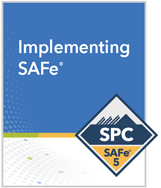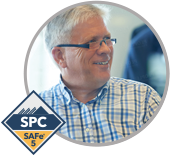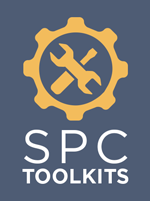…the people who are crazy enough to think they can change the world are the ones who do.
—Apple’s 1997 Think Differently Campaign
Certified SAFe® Program Consultant
Certified SAFe® Program Consultants (SPCs) are change agents who combine their technical knowledge of SAFe with an intrinsic motivation to improve the company’s software and systems development processes. They play a critical role in successfully implementing SAFe. SPCs come from numerous internal or external roles, including business and technology leaders, portfolio/program/project managers, process leads, architects, analysts, and consultants.Details
A Critical Role for a Critical Need
As outlined in the Implementation Roadmap series, changing the development practices and behavior of an enterprise is a significant challenge. To achieve meaningful and lasting change, author John P. Kotter notes that a “sufficiently powerful guiding coalition” of stakeholders is needed [1]. Such a coalition requires:
- Leaders who can set the vision, show the way, and remove impediments
- Practitioners, managers, and change agents who can implement specific process changes
- Sufficient organizational credibility to be taken seriously
- The expertise needed to make fast, intelligent decisions
In enterprises new to SAFe, many of these attributes rest with experienced and trained SPCs.
Responsibilities
As knowledgeable change agents, SPCs participate in many of the activities identified in the 12 critical moves described in the SAFe Implementation Roadmap. Specifically, they assist with:
- Reaching the tipping point – They communicate the business need, urgency, and vision for change.
- Training executives, managers, and leaders – They socialize the new concepts and provide orientation and overview training. SPCs teach Leading SAFe and facilitate modules of the Leading in the Digital Age series for leaders, managers, and stakeholders.
- Establishing a Lean-Agile Center of Excellence (LACE) – SPCs assist the LACE with building and executing the transformation backlog.
- Identifying Value Streams and Agile Release Trains (ARTs) – Working with stakeholders to understand the flow of value, SPCs facilitate the identification of Operational Value Streams, Development Value Streams and ARTs to find those that are the most opportunistic for launch.
- Creating the implementation plan – SPCs participate in creating a plan for the rollout, communicate upcoming changes, and establish metrics.
- Preparing for the ART launch – SPCs help the LACE plan and prepare for the ART launch. They coach leadership and help facilitate the creation of new Agile Teams. They also train or source training of executives, leaders, Agile teams, and specialty roles—such as Product Owner, Product Manager, Scrum Master, and Release Train Engineer (RTE). They also assess and evolve launch and backlog readiness.
- Training teams and launching the ART – SPCs often directly plan and execute ‘quickstart’ or other rollout strategies. They train or source training for teams and participate in initial, critical events like Program Increment (PI) Planning and Inspect and Adapt (I&A). SPCs help establish the ART launch date and calendar for ART and Team events.
- Coaching ART execution – The SPCs coach leaders and stakeholders to build and maintain the Vision, Roadmap, and Program Backlogs. They coach teams, Product Owners, Product Managers, Architects, and RTEs. They guide the shift from project-to-product with a focus on Customer Centricity and Design Thinking as part of Agile Product Delivery. They also participate in Scrum of Scrums and System Demo, facilitate I&A and follow-up on improvement items. Finally, they help teams establish a DevOps culture and mindset, the Continuous Delivery Pipeline, infrastructure, and associated Agile technical practices.
- Launching more ARTs and value streams – SPCs work to enable new change agents to increase organizational capacity to support new value streams, start more ARTs, and expand the reach of the LACE. They communicate progress and highlight early accomplishments.
- Extending to the portfolio – Once Lean-Agile practices gain momentum, SPCs can socialize and drive those practices to the portfolio level, including Portfolio Vision, Lean Budgets using Participatory Budgeting and Guardrails, Lean Portfolio Management, leaner approaches to CapEx and OpEx, and Agile Contracts. They also communicate the value of Strategic Themes. (Note that some organizations may opt to implement LPM much earlier in their SAFe transformation.)
- Accelerating – An enterprise’s SAFe journey doesn’t end with the launching of trains and the adoption of Lean Portfolio Management. SPCs have expert mastery of the seven competencies of the Lean Enterprise and how they contribute to achieving Business Agility. They are proficient in using the assessments described in Measure & Grow to help organizations understand where they are on the path to business agility. SPCs can also help develop the action plans that the enterprise to grow in each of the 21 dimensions across the SAFe competencies.
How Many SPCs Do You Need?
At first glance, the list above seems daunting. No single SPC could accomplish all this alone. Viewed broadly, however, the knowledge and skills of an SPC can’t be limited to a few select people. Instead, many leaders across the emerging Lean-Agile business must master these distinctive new competencies. This means most companies will need to have many SPCs (perhaps as many as 3 – 5 per 100 development practitioners) to drive and sustain the implementation.
Training SPCs
 SPCs must be trained for their new role, acquiring the skills and tools needed to execute their responsibilities, as well as to coach and teach others to implement and support the change. The best way to achieve this is to take the Implementing SAFe with SAFe® Program Consultant (SPC) certification class. This four-day course prepares SPCs to become the change agents who lead the transformation. Attendees learn how to effectively apply the principles and practices of SAFe and organize, train, and coach Agile teams. They also learn how to identify value streams, identify and launch ARTs, and help build and manage an Agile portfolio.
SPCs must be trained for their new role, acquiring the skills and tools needed to execute their responsibilities, as well as to coach and teach others to implement and support the change. The best way to achieve this is to take the Implementing SAFe with SAFe® Program Consultant (SPC) certification class. This four-day course prepares SPCs to become the change agents who lead the transformation. Attendees learn how to effectively apply the principles and practices of SAFe and organize, train, and coach Agile teams. They also learn how to identify value streams, identify and launch ARTs, and help build and manage an Agile portfolio.
Scaling Lean-Agile across the enterprise also requires training all the people who do the work. To make this practical and cost-effective, Scaled Agile, Inc. supports a train the trainer, fan-out model, licensing SPCs to teach SAFe courses that support the other key roles in the implementation. This provides an affordable training strategy and supplies the trainers needed to achieve the mission of company-wide change.
I’m an SPC, Now What?
After passing an exam, attendees become certified SPCs, gaining access to a variety of helpful SPC resources to facilitate SAFe adoption. They will also be licensed to teach the courses listed here.
Learn More
[1] Kotter, John P. Leading Change. Harvard Business Review Press, 1996.
Last update: 10 February 2021







